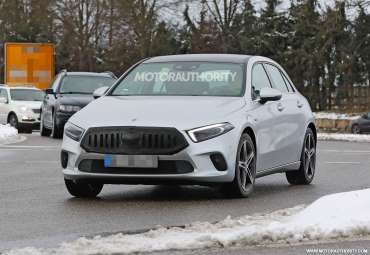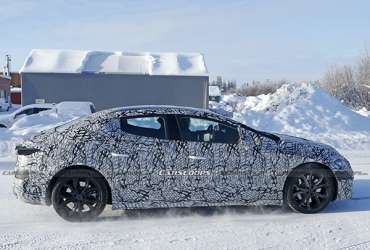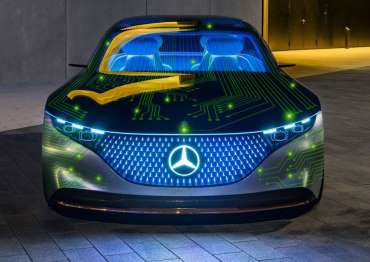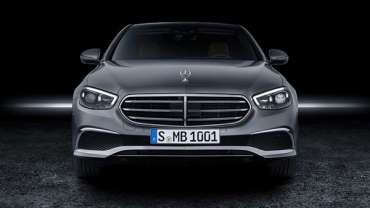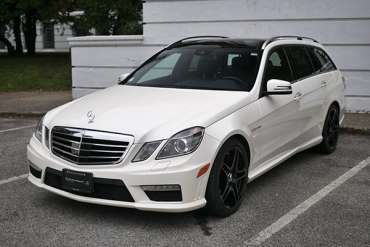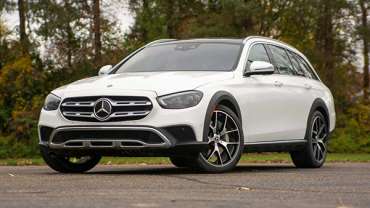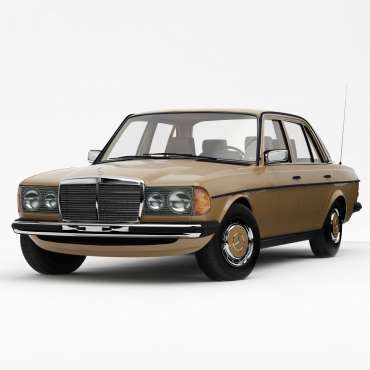Displaying items by tag: MercedesBenz
2023 Mercedes-Benz A-Class hatchback spy shots: Mid-cycle update in the works
The Mercedes-Benz A-Class is about to come in for a round of updates, as evidenced by a prototype spotted in Germany.
The prototype is for an updated version of the A-Class hatchback sold outside the United States, but we should see the same changes introduced on the sedan variant we get here.
The current A-Class arrived in 2018 as a 2019 model. We should see the updated version introduced in 2022 likely as a 2023 model.
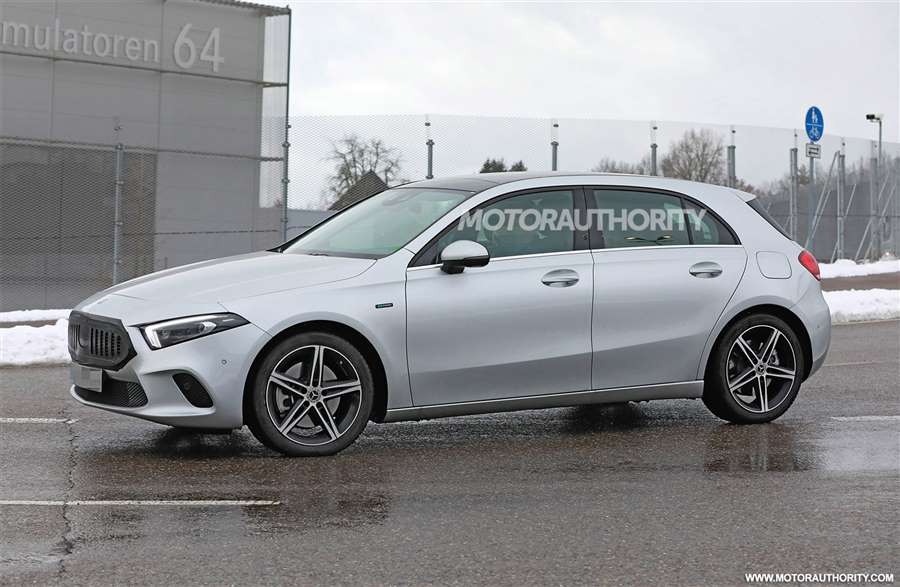
We're still at a very early stage of development. Right now only the grille is camouflaged, and looking through the gaps we can see that there's a new mesh pattern. It also looks like the center of the grille, where the Mercedes logo would normally sit, will house a sensor for the electronic driver-assist systems. It's possible the sensor will be integrated with the logo in the updated A-Class.
It isn't clear at this early stage what other changes are planned. It's possible a plug-in hybrid powertrain is finally offered in the U.S. with this update. One has been available in other markets since 2019. In fact, this prototype is a plug-in hybrid, an A250e. The powertrain is comprised of a 1.3-liter inline-4 and an electric motor-generator integrated with an 8-speed dual-clutch transmission. System output is 217 hp and 332 lb-ft of torque, and the exhaust vents from underneath the car which is why you can't spot exhaust tips.
The A-Class is currently offered exclusively with 2.0-liter turbocharged inline-4s in the U.S. The base version has a modest 188 hp but you can get an A35 from AMG, which packs 302 hp.
Don't look for a battery-electric A-Class. Mercedes had planned to launch an electric A-Class at one point but decided to focus on crossover body styles instead, hence the reason it has just launched the GLA-Class-based EQA and will soon add a GLB-Class-based EQB.
Mercedes-Benz EQE Will Be Smaller Than The E-Class
Mercedes-Benz is going all-in on their EQ line of vehicles, with six new cars confirmed to launch over the coming months and years. We’ve already seen spy shots of the EQS Sedan, which will be unveiled later this year. This time it’s the turn of the smaller EQE Sedan.
The EQE Sedan will be the second car to use Mercedes‘ new Electric Vehicle Architecture (EVA). Like the EQS Sedan, it’ll follow the hierarchy set by their legacy models, meaning that the EQE will play in the same segment as the E-Class.
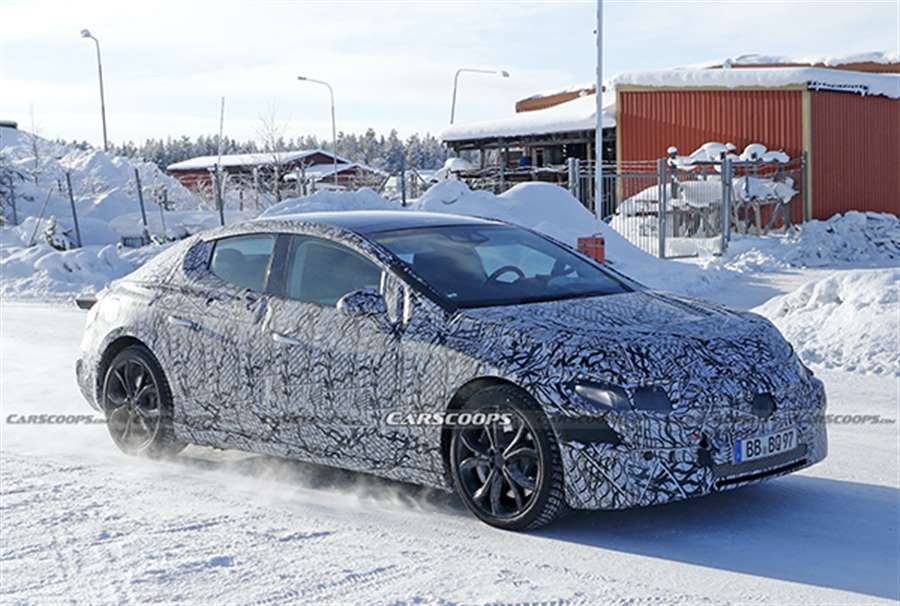
However, the EQE won’t just be a simple rework of the E-Class body shell. It will be based on the new Modular Electric Architecture (MEA) and feature a swoopy cab-forward design, as we’ve seen with the EQS, inspired by the Mercedes Vision EQS concept car.
Like the EQS Sedan, the EQE Sedan (codenamed V295) will spawn an SUV variation. In what could prove to be a confusing naming convention, this soft-roader be called the EQE SUV.
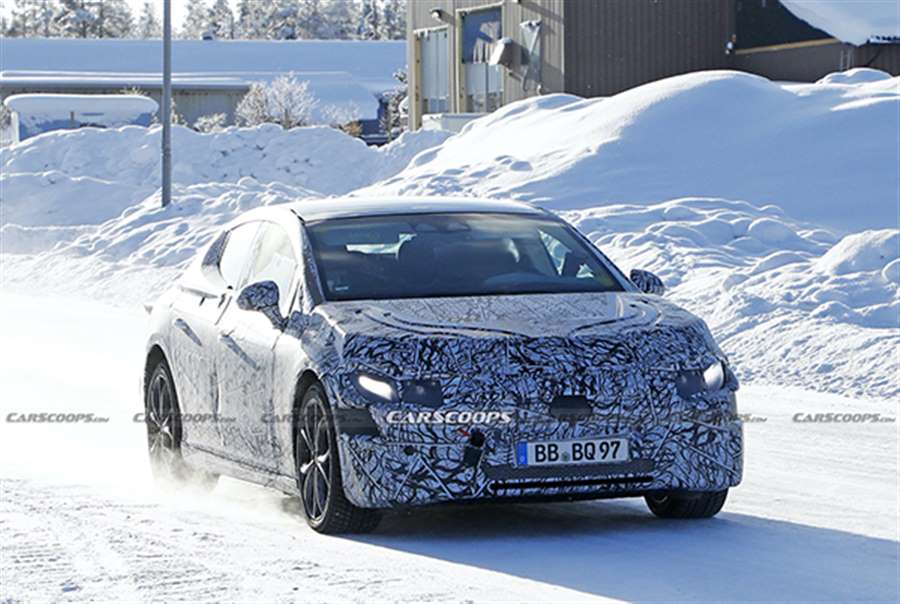
From these images, it’s evident that the EQE is smaller in overall diameter than the EQS Sedan, with our spy photographers noting that it may even be slightly shorter overall than the current E-Class. But, thanks to the EVA platform’s flat-floor design, the interior is likely to be more spacious than the ICE-power car.
The EQE also offers a “proper” boot, unlike the five-door lift-back style featured on the EQS. The side profile’s most striking feature is how the beltline sweeps up in a manner not often seen in a Mercedes-Benz design. That said, the heavy camouflage and body panel disguise would indicate that the outlines of the rear quarter panels and the hood are not to be believed just yet.
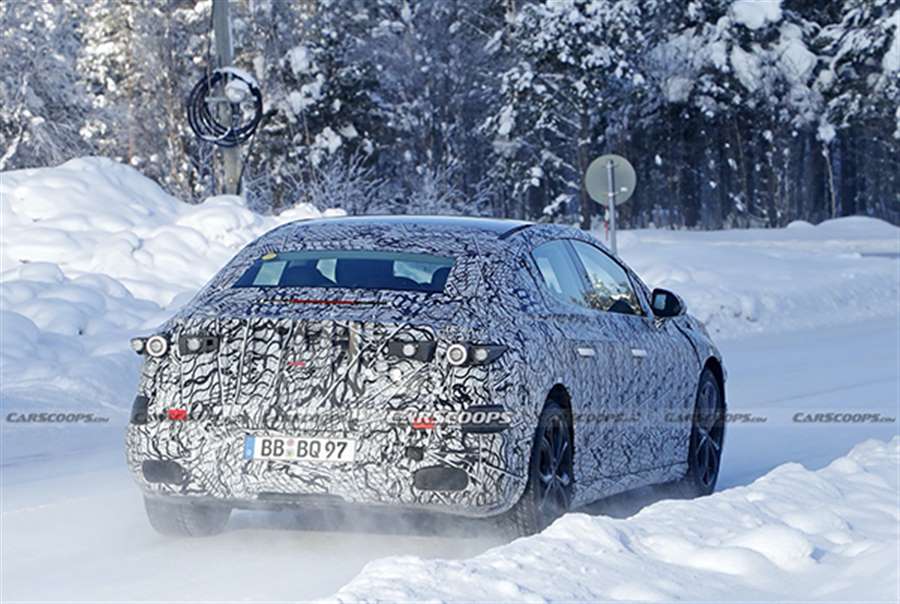
The interior is expected to feature a version of the forthcoming MBUX Hyperscreen. The boundary-breaking dashboard features three screens sitting under one massive expanse of glass. The glass stretches from door to door and allows the front-seat passenger to have their own dedicated display.
Powertrains are yet to be confirmed, as the car itself looks set to be a 2022 model. What we expect, though, are twin motor setups with all-wheel drive. The German carmaker aims to offer the bigger EQS Sedan with a driving range of up to 435 miles (700 km), so expect to see similarly impressive figures from the EQE as well.
There’s also a strong likelihood that we’ll see AMG models of the EQE Sedan as well, set to take on the likes of the Taycan, e-tron GT, and Tesla Model S. Read more > https://mercedes-world.com/eq/mercedes-benz-eqe-e-class
Starting in 2024, Full Mercedes-Benz Lineup Will Have Autonomous Capabili
Newly announced partnership with Nvidia will include over-the-air upgrades and could even yield a Mercedes App Store.
- Mercedes-Benz and Nvidia have announced a new partnership that will bring upgradable AVs and, maybe, a Mercedes App Store.
- This new deal doesn't exactly replace Benz's previous deal with BMW, which was put on hold last week due to future model timing.
- Based on the Nvidia DRIVE platform, the new partnership will be used in every next-generation Mercedes-Benz vehicle starting in 2024.
When planning for the future, it doesn't hurt to give yourself some options. Last year, for example, Mercedes-Benz and BMW announced that they would work together on autonomous passenger cars that would be available to private customers starting in 2024. Last week, that cooperation effort was put on hold and then this week, Mercedes announced a new partnership with Nvidia on automated-driving technology to be trolled out in new Benzes starting in 2024.
Even though that could be read as Daimler swapping out BMW for Nvidia for its upcoming AV tech, the reality is a bit more complicated. A Mercedes-Benz spokesperson told Car and Driver that the cooperation with Nvidia is independent from the one that was planned with BMW. "The timing with planned models from BMW did not fit, that is why we put the cooperation on hold and may resume later," she said. "With Nvidia we are looking at a software-defined architecture for automated driving features. This is different to what was planned with BMW."
Different and bigger. Danny Shapiro, Nvidia's senior director of automotive, told C/D that the future that his company's new deal with Mercedes-Benz offers comes with support from the top, which means Nvidia CEO Jensen Huang and Mercedes-Benz AG CEO Ola Källenius.
"Don't think of [the announcement] as a product but a change in strategy and architecture that [Mercedes'] entire future lineup is based on," he said. "It's very significant on both sides. It's rare for an automaker to put so much trust in another company. Ola and Jensen have been working very, very closely on this. It's top down in both companies."
Every Mercedes Will Get Nvidia's AI Supercomputer
So, what's in the deal? As Shapiro said, a lot. Mercedes-Benz and Nvidia are going to build a new software-defined computing architecture for automated vehicles based on the Nvidia DRIVE platform that will be installed across the fleet of next-generation Mercedes-Benz vehicles, starting in 2024.
"It's really a transformative business model for Nvidia and Mercedes-Benz," Shapiro said. "The entire fleet, every car from the entry A-classes to the S-classes, will have the highest-performance Nvidia AI supercomputer on board."
Shapiro said that each of these new Mercedes vehicles will come with the full surround sensor suite installed and then, similar to how Tesla does things today, it will be up to owners to decide if they want to activate features, either when they purchase the car or after the fact with an over-the-air update. "There will be different business models, subscription service possibilities or one-time fees or things like that, depending on the region, that potentially turns the car into a fully upgradable, perpetually upgradable device, and there potentially could be be a Mercedes App Store," he said.
The features include what Mercedes calls "state-of-the-art automated driving functionalities" that will be able to "automate driving of regular routes from address to address," but since Mercedes is only promising Level 2 and 3 autonomous driving, the driver may need to take over in some situations during the drive. Mercedes says future automated parking functions that use this system could offer up to Level 4 capabilities, which means the car could go park on its own.
Source: caranddriver.com
2021 Mercedes-Benz E-Class Will Be The Last Model To Have Hood Ornament
Hood ornaments are dying. They have been for a long time, due to both safety concerns and automotive fashion trends. Jaguar laid down its leaper years ago, Lincoln’s crosshair thing was shot down years back, and Cadillac’s ornate wreath crest fell off its vehicles’ hoods and into the grille decades ago (then lost its wreath!). Mercedes-Benz remains one of the few bastions in the automotive space for the seemingly quaint marker, alongside Bentley and Rolls-Royce. But the majestic, hood-mounted three-pointed star is facing down a similar fate, at least here in the U.S.
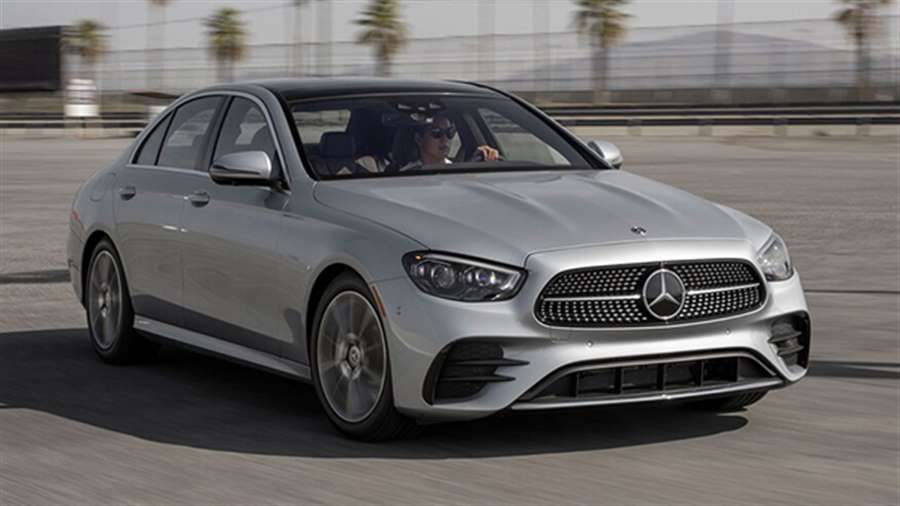
The ’21 E-Class represents a remarkable mid-cycle update of an existing car, with Mercedes having improved and made over the luxury sedan, coupe, and wagon so deftly the E earned our MotorTrend Car of the Year award. It also represents the latest Mercedes model to lose its old-timey hood ornament, after the C-Class, SL-Class, and others, even though it had already been relegated to the fringes of the E-Class lineup here in America. The option is missing from the 2021 E-Class’s online configurator, and Mercedes has confirmed it no longer is available.
Previously, the E-Class was available in so-called “Luxury” trim, with a classic-style Mercedes grille—empty, with only chrome slats—and a three-pointed star perched atop a small plinth rising from the hood. The other trim, “Sport,” represents the vast majority of pre-refresh E-Classes and is the version you’re probably most used to seeing; where the hood ornament would be, it wears a flush button with Benz’s crest on it, and a more modern-style grille with a huge three-pointed star embedded in the center. The Luxury line also brought a more comfort-tuned suspension, tamer wheel designs, and other selections geared toward old-school Mercedes luxury instead of new-age, racetrack-tuned aggression common in the luxury car market these days.
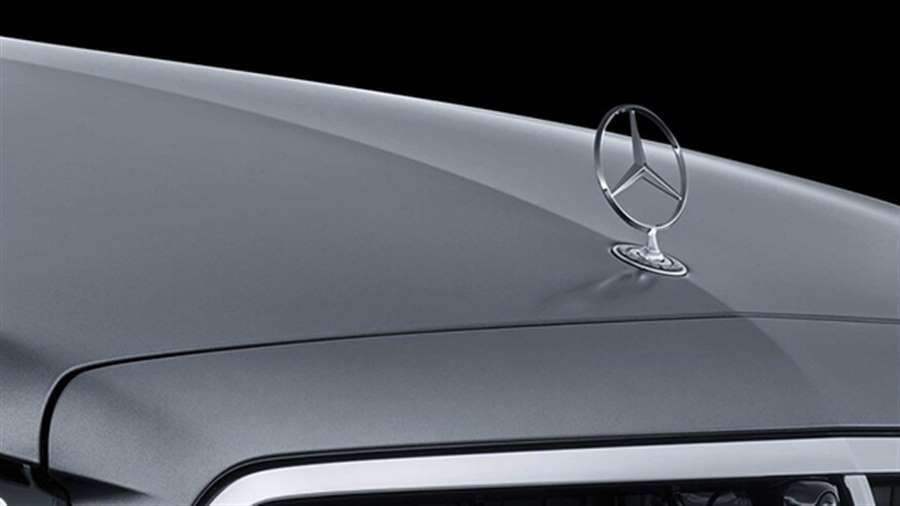
Both the E-Class sedan and the station wagon were available in genteel, distinguished Luxury trim; now, there is no Luxury styling package available. But before the days of Luxury and Sport lines, the E-Class came with the hood ornament by default. That was phased out after the W211 generation was replaced in 2009 (pictured second from right, below); in that generation, even the high-performance E55 AMG model wore a proper hood ornament. It was the following generation (pictured far right), the W212, that introduced the star-in-grille style favored across the Mercedes lineup today to the E-Class.
Why, you might be asking, does any of this matter? Hood ornaments have been on the outs for years, what’s one more? The removal of the star hood ornament from the E-Class brings the well-worn trend to the doormat of Benz’s very core. Today’s E-Class can trace its lineage back through iconic mid-size vehicles that helped establish and cement Benz’s luxury credentials, including the W123-generation 200- and 300-series models, which are renowned for their bulletproof reliability, excellent build quality, and signature ka-chunk door closing sounds (a delight which today is only known to G-Class SUV buyers). What did all of those E-segment cars have in common? Hood ornaments keeping watch over a simple horizontal-slat grille.
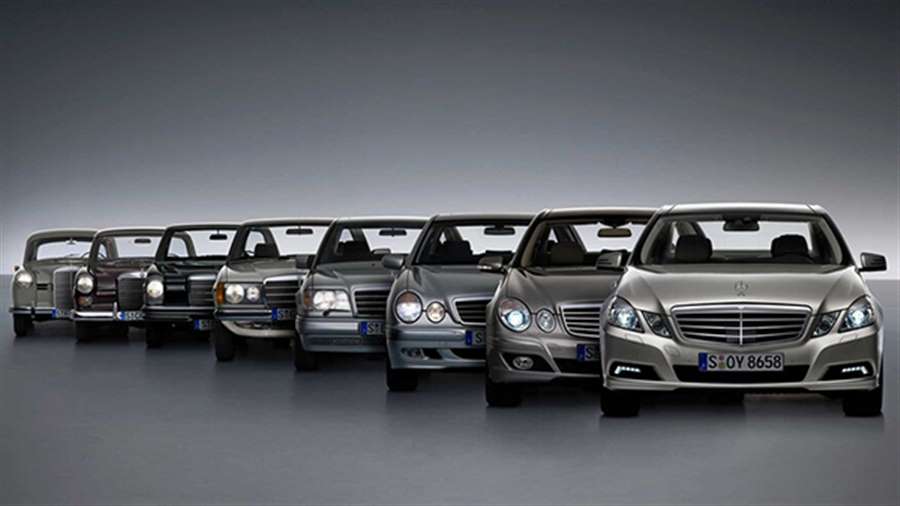
It may come as small consolation, but Mercedes-Benz seems aware of the history and character tied up in its iconic hood star. Just look at the vehicles it continues to offer the hood ornament on: The all-new S-Class sedan, the standard-bearer for full-size luxury sedans, as well as the super-luxurious Maybach GLS SUV and S-class sedan. So, while the hood-mounted star may be gone from the E-Class’s option sheet, it’s not totally gone yet.
Should you want to indulge in today’s best mid-size luxury sedan, coupe, or wagon but just can’t stand the Mercedes star in the grille, we can offer you some hope. Mercedes-Benz designed and sells a version of the 2021 E-Class in Europe with the old-school grille and ornament treatment. We reckon that, were you to purchase the parts from Germany, you could (perhaps with some fabrication or creativity, depending on market-driven bumper and hood differences) fit them to your very own E-Class. After all, the grille shape suggests that piece is interchangeable, and the U.S.-market E-Class’s flush-mounted hood “button” appears to be in the same spot (and the same shape) as the hood ornament’s mount. Because there is just something special about driving a Mercedes and seeing that star hovering out over the edge of the hood and pointing the way. mercede-world.com
Source: mercedes-world.com
Mercedes-Benz E 63 AMG Wagon 550-Horsepower Could Be The One For You (photo + video)
Looking for a performance car that you can also use for the daily school run? This 2012 Mercedes-Benz E63 AMG Wagon could be the one for you.
We’re living in an era where SUVs have become the go-to vehicles for those looking for family cars, but performance-focused wagon/estate vehicles have something undeniably cool about them. This E63 AMG Wagon currently residing in Burnaby, British Columbia, Canada, looks to have been well maintained and will make its future owner stand out from the droves of SUVs that have seemingly taken over the streets.
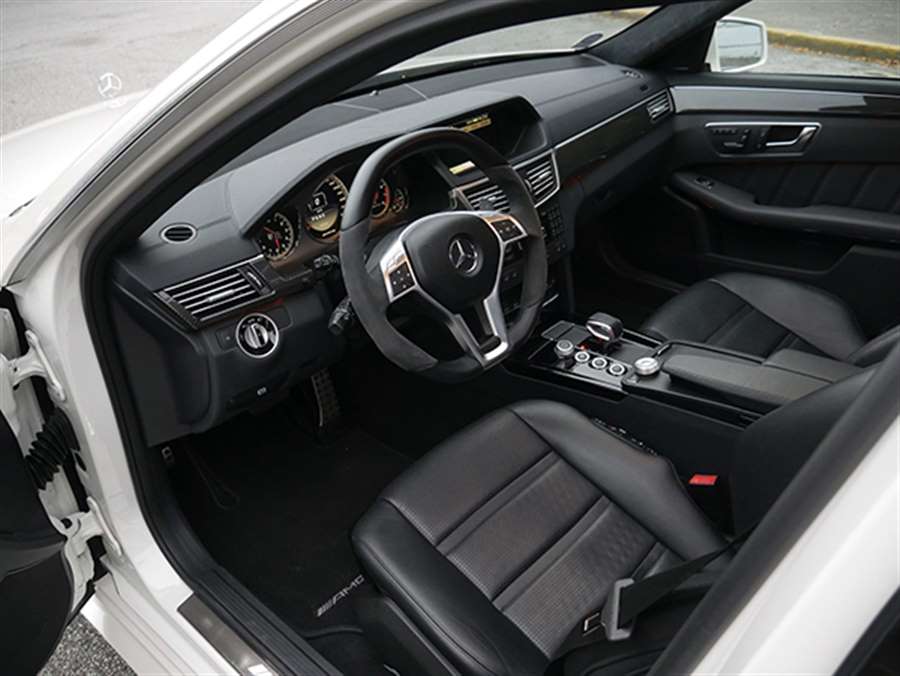
The Bring A Trailer ad lists that the car is finished in Diamond White Metallic and sits on factory 19-inch AMG wheels finished in black and wrapped in staggered-width Michelin Pilot Super Sport tires. Adding to the wagon’s desirability is the fact that it is equipped with the factory P30 Performance Package that boosts power to 550 horsepower and 590 lb-ft of torque routed to the rear wheels through a seven-speed automatic. It also includes a stiffened electronically adjustable sport suspension and an AMG-specific braking system with cross-drilled rotors and red calipers.
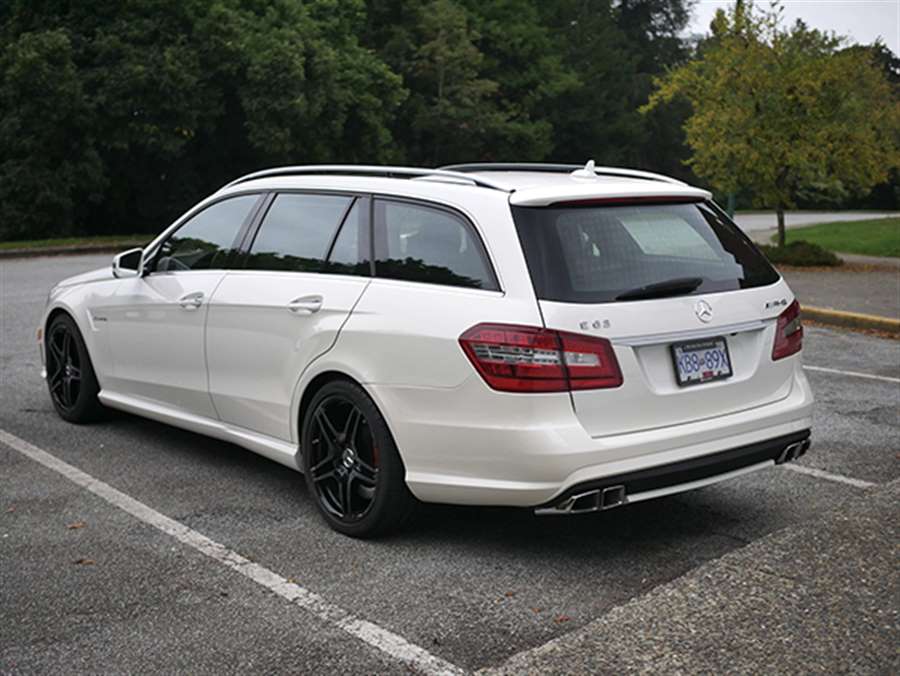
Inside, the Merc features black semi-aniline leather across the seats and door panels, various carbon fiber accents and a black Alcantara headliner. It also has powered, heated, and ventilated seats with memory functions, a panoramic moonroof, Blind Spot assist, lane tracking, and illuminated door sills.
This E63 AMG Wagon has been driven 103,000 km (~64,000 miles) and was serviced in October and fitted with new differential side cover seals, axle nuts, and front sway bar links. It is being sold with service records, factory literature, accessories, two Carfax reports and a British Columbia registration.
{vembed Y=uNOe5w60jw}
Source: mercedes-world.com
Mercedes-Benz E 450 All-Terrain 2021 Review
Once upon a time, station wagons dominated America’s roadways. They were the preferred mode of transport for frugal families road-tripping across the country until the arrival of the minivan. Today, wagons make up a sliver of new vehicle sales. That’s despite a surge in models that blur the lines. Traditional wagons exist and continue to appeal to consumers looking for something different, but high-riding, ruggedized long-roofs are becoming more and more common.
Subaru is the most successful purveyor of this sort of car, but Volvo has its Cross Country range and Audi is expanding the Allroad line with a new A6 Avant-based model. These vehicles attempt to marry the appeal of wagons – that they’re interesting, different holdovers of another time – with the air of capability that makes crossovers popular. For 2021, Mercedes-Benz is getting in on the action, discontinuing its E450 Wagon and introducing the E450 All-Terrain.
Packing a standard air suspension , a boost in ground clearance, and some rugged body mods (not to mention the same changes introduced on the broader E-Class line for 2021) does mean added capability. But even with these new touches, this high-riding wagon feels too much like its traditional counterpart in a few important ways.
Looking The Part
The E-Class All-Terrain’s new headlights, more prominent grille, and tweaked front bumper conspire to produce a more premium, attractive face than last year’s E-Class Wagon. And where the back of the revised E sedan looks worse than its predecessor, the designers left well enough alone on the wagon, retaining the slim, horizontal taillights and a wide-opening aperture with a low lift-over height.
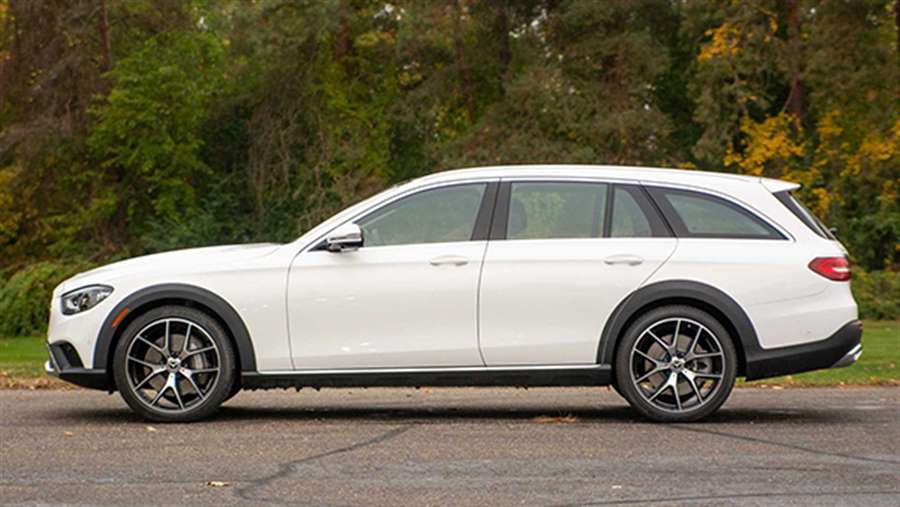
The All-Terrain differs from its predecessor, though, with prominent black plastic around its wheel arches and side sills. The 2021 model is no wider than last year – both cars span 73.7 inches, not including the mirrors – but there is a subtle flare to the arches that produces more visual mass. There’s also black plastic on the front and rear bumpers, although the protection on offer is minimal (this is no G-Wagen).
The car’s stance is more purposeful, although our tester left us scratching our head with its optional 20-inch wheels.
Completing the tougher look is a boost to the E450’s ride height. The now-standard air suspension offers 5.8 inches of ground clearance, 2.0 inches more than what you got from last year’s E450 Wagon. The car’s stance is more purposeful, although our tester left us scratching our head with its optional 20-inch wheels. They look good and are a visual benefit to the car overall, but big wheels and skinny sidewalls don’t give the impression of SUV-like toughness.
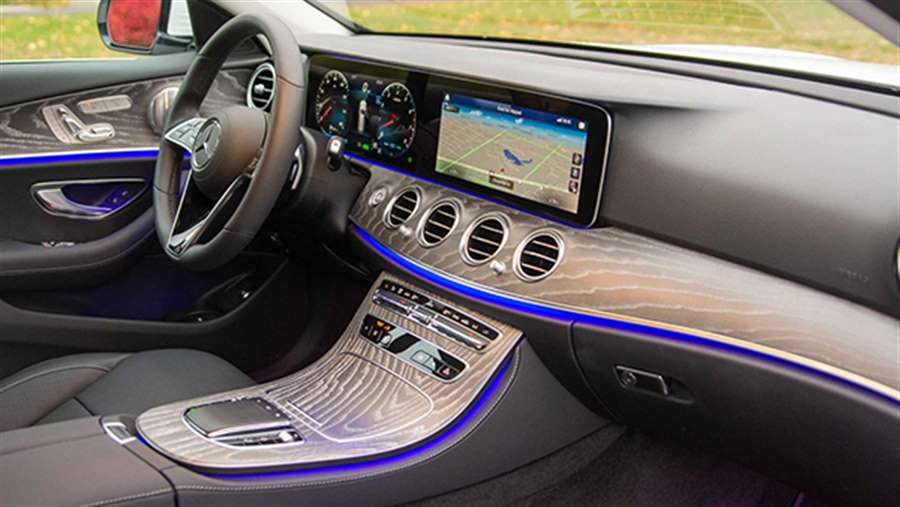
Mercedes made one significant change to the E-Class cabin, with every variant receiving a new steering wheel design. The company opted to replace physical buttons and scrollers with touch-capacitive controls. Some work, like the “buttons” that activate and adjust the cruise control. But the important controls – the volume slider and the directional pads for controlling the digital instrument cluster and infotainment system – tend to have a mind of their own.
Almost All Terrain
This is not a Mercedes problem, but these lifted wagons are rarely as capable as they look. In the E450 All-Terrain’s case, though, the bones are good. The air suspension allows up to an inch of height adjustment, and new Offroad and Offroad Plus driving modes, plus hill descent control, provide an easy avenue for tweaks to the suspension, stability control, and powertrain.
The chink in this car’s armor is, as is often the case, its tires. The E-Class is only available with 19- or 20-inch wheels with 245/45/19 or 245/40/20 tires, respectively. Our tester featured the larger option and was perfectly fine on smooth and paved roads. The soft air suspension soaks up abuse so well that you aren’t even aware you’re riding on rubber bands. But dirt roads are an anxiety-inducing experience, to the point that we can’t understand why Mercedes engineered dedicated off-road driving modes – they’re moot with the factory wheel/tire choices.
It’s a miracle the E450 survived our dirt-road session without a flat tire.
We integrated 90 minutes of dirt-road driving – typical stuff for rural Michigan – into our usual test loop, and it’s a miracle the E450 survived without a flat tire. Bumps that didn’t look all that significant sent a groan-inducing shudder through the body, preceded by the instantly identifiable clunk of a wheel accepting forces that the tire should handle. While it hurts the aesthetics, the first thing we’d do with an E450 All-Terrain is drop the wheel diameter to 17 or 18 inches and then fit the thickest sidewalls the car could accommodate without rubbing – there’d be a dramatic improvement in dirt-road comfort.
Still Works As A Wagon
Despite the All-Terrain treatment, the E450 still works as a suburban runabout. Packing a new engine for 2021 – a non-AMG version of the E53’s turbocharged, mild-hybrid straight-six – and standard all-wheel drive, this wagon offers innocuous performance around town. There’s 362 horsepower and 369 pound-feet of torque – identical to the E450’s old twin-turbo V6 – and while Mercedes isn’t publishing a zero-to-60 time, we’d wager it remains in the five-second range.
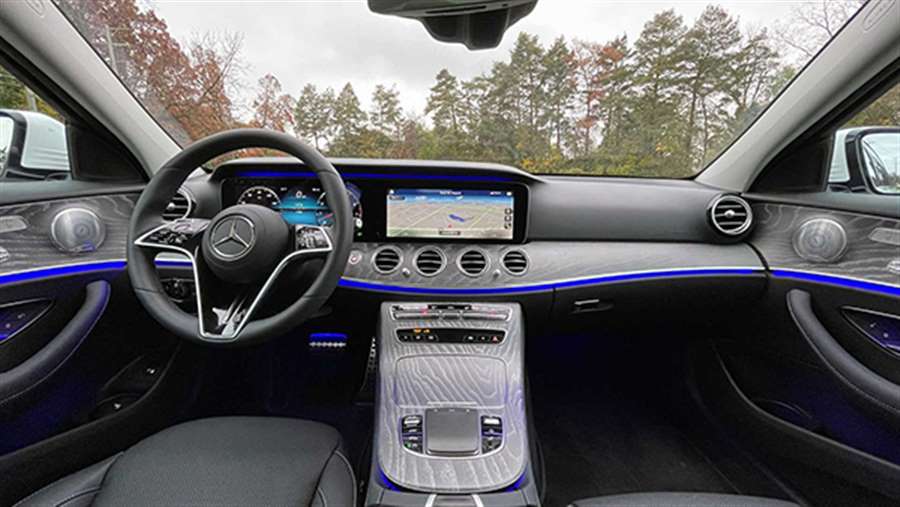
The 2021 E450 doesn’t feel any quicker than its predecessor, but the new mild-hybrid engine is far, far smoother. That’s partially down to the inline layout – arranging six cylinders in a row is inherently better than putting them in a V – but also thanks to the EQ Boost mild-hybrid system, which uses a 48-volt electrical architecture to power a compressor that immediately spools the turbocharger. The combo of these two things means that off the line, the All-Terrain accelerates like the more luxurious, refined car. The new engine is quieter, for a start, but what you hear is smoother and more pleasant, too.
Despite the All-Terrain treatment, the E450 still works as a suburban runabout.
Meanwhile, the added ride height has only a small impact on how the All-Terrain handles. There’s more body roll, which makes sense, but it’s easy to predict how the car will respond to inputs. Overall grip levels are high too, owing to the wildly inappropriate-for-an-off-roader Pirelli PZero rubber. This is an easy car to hustle about.
Price Is Still An Issue
Ultimately, and as was the case the last time we drove an E-Class Wagon, we’re still concerned about the cost of this variant and the limited number of configurations it’s available in. The All-Terrain only offers the 3.0-liter EQ Boosted straight-six, while its $67,600 starting price is over $10,000 more than a GLE 350 4Matic and $5,100 more than its nearest counterpart, the GLE 450.
Those points aside, the All-Terrain has one big pro we haven’t mentioned: exclusivity. Mercedes imports precious few wagons to the United States each year, making the E450 and its AMG counterpart, the E63, two of the company’s rarer vehicles. That hasn’t been enough to motivate customers in the past, but with a ruggedized alternative to the traditional wagon arriving in showrooms soon, it’s possible that Mercedes may see some more interest from American consumers looking for something different. Read more > https://mercedes-world.com/e-class/mercedes-benz-e-450-all-terrain-review
Source: mercedes-world.com
Mercedes-Benz W123 (1975-1986)
Mercedes-Benz W123 (1975-1986)
The Mercedes W123 cars, produced from 1975 to 1986, were hugely popular all over the world. This model was sold in 2,4 million cars.
In 1980 the Mercedes W123 was the best-selling car model in Germany,
The W123 became a hit with the public due to its modern look. Following the slow build-up during the first year of production as to ensure the high and consistent quality, the customers who placed their orders faced a lengthy waiting period of nine to twelve months.
Interesting fact was that black market emerged for the customers who were willing to pay more for immediate delivery.
This model of Mercedes was well-built, durable, and reliable. Many taxi companies chose W123 for this reason, and they were common sight in Germany. Reaching 500,000 or 1,000,000 km with minor mechanical issues was common with W123 used as taxicabs.
W123 production ended in January 1986 with 63 final T-models rolling out. Most popular single models were the 240 D (455,000 built), the 230 E (442,000 built), and the 200 D (378,000 built).
Where is the best buy? What is the price?
Market price of this oldtimers Mercedes W123 is around $ 30,000.00 is is in good and original condition.
If you look for such a car, you can find it under lower price in East Europe.

